Fast as a Speeding Masonry Unit
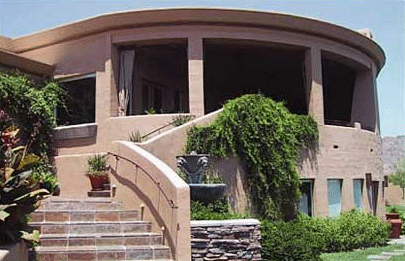 This luxury home in Arizona took advantage of the cost savings and speed that comes with using interlocking CMUs. Photo courtesy of Haener Block |
We're going to discuss four new brick and block systems that all aim at ? among other things ? cutting down on the amount of labor it takes to install a masonry system.
CMUs
Walking through any of the spring construction trade shows you would have certainly noticed the various new breeds of CMUs available, all of them touting their affordability and ease of use compared to traditional masonry blocks. Three of these exhibitors included Haener Block of San Diego, Calif.; U-Block, Inc., of St. Augustine, Fla.; and Verot Oaks Building Blocks, Inc., of Lafayette, La.
Haener Block
This mortarless and interlocking block has been used in thousands of structures, from simple walls to casinos and hotels. Haener offers an 8x8x16 standard size, weighing approximately 34 pounds, with an 8x8x8 half block. It also offers 6", 8" and 12" sizes.
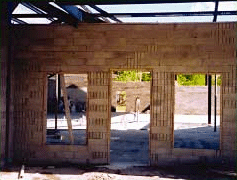 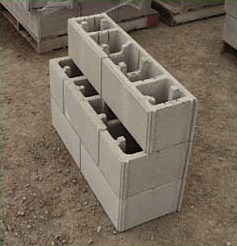 Haener's brick ledge system for basement construction. The eight? and 12?inch blocks interlock to create a four?inch brick ledge. Photo courtesy of Haener Block |
Verot Oaks Building Blocks, Inc. (VOBB)
VOBB's dry-stacked units are based on a grid of six inches ? all six inches high and six inches wide. The units are offered in 18" (22-31 pounds), 12" (15-21 pounds) and 6" lengths (7-11 pounds).
"Generally, in a typical home, based on the number of doors, windows and corners, the 18" is used 85% of the time, the 12" is used 10%, and the 6" is used 5%," says John (JG) Guy, President of Verot Oaks Building Blocks.
Several things distinguish the VOBB units. First, they are "rolled" while they are still green to achieve a consistent height. Also, the units use grooves and special removable clips to help keep them aligned until the grout is poured or pumped into the cavities.
U-Block, Inc.
For those wishing to keep a mortar joint, U-block offers the quickness of a tongue and groove design, which also helps to create a perfect mortar joint.
"Because the male tongue is 6/8" and the female is 3/8", this allows for a consistent and uniform 3/8" mortar joint," says John Ruggeri, President of U-Block, Inc. "This unique design feature allows U-Block to lay straighter, tighter and quicker than standard CMUs."
U-Block can be created as any size needed, but the standard size is 8x8x16 with a weight of 27 pounds.
Although there are several distinctions among these three in particular, there are many similarities they share that ultimately will help mason contractors come out on top.
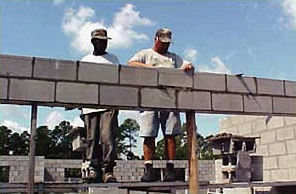 Photo courtesy of U-Block, Inc. |
Bouchard claims that, "One person can lay up to 13 blocks a minute."
The interlocking features also give mason contractors the ability to use less experienced laborers in laying the block.
"This block self-aligns and self-seats, allowing the mason contractor to use apprentice labor and still be just as accurate or greater than with regular blocks," says Ruggeri. "Being able to use laborers alongside masons allows mason contractors to have a bigger crew and schedule more work."
All of these advantages lead up to two things for mason contractors: overall cost savings and keeping masonry competitive with other types of building systems.
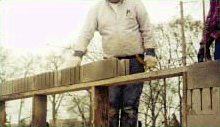 Photo courtesy of Verot Oaks Building Blocks, Inc. |
Guy sees a bigger picture that goes beyond the cost of one project alone.
"By lowering the cost, the contractors will be more competitive against tilt-ups, ICF, wood and metal buildings," Guy says. "We believe that the opportunity to build millions of homes with quality masonry is realistic based on the cost of the home being affordable.
"VOBB will definitely be able to compete against homes built out of termite food and firewood due to the quality of masonry and the affordable cost of dry stacking. We believe that every person in the USA deserves to live in a quality home built with all exterior and interior walls being built with concrete block."
Brick
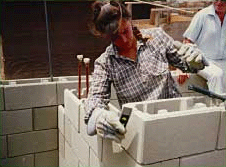 Haener's interlocking system has been used for projects ranging from simple walls to huge casinos. This picture shows how these units were used by Habitat for Humanity in Mexico. Photo courtesy of Haener Block |
"The advantage of the Azar dry-stack block and brick rests within the design," says Tony Azar, President of AMBS. "The blocks can be interlocked both horizontally and vertically. The result is mortarless units that perform in both below- and above-grade applications!"
The new Azar brick is a mortarless veneering brick for exterior walls. Compared to traditional brick, the product is inexpensive and can be constructed within a fraction of the time of traditional mortared walls. Plus, because the unit uses clips instead of mortar, the veneer can be undertaken in any weather because there are no temperature restrictions.
"A groove in the back of the brick allows a plastic clip to be inserted and can move horizontally along the length of the brick," explains Azar. "Once in place, the plastic clip is then secured to the rough walls by a double-headed metal screw that can be adjusted inward or outward resulting in a perfectly straight wall."
Part of the trick with these new systems is that, although everyone wants a system that installs faster, they don't necessarily want it to look any different from what is considered a traditional masonry wall. Like with the interlocking CMUs, these masonry units keep the traditional appearance that customers have grown to love, but it takes half the time to install.
"Reduced time, costs and skilled labor is a revolution in the masonry industry," Azar sums up. "AMBS raises the bar in the masonry industry and offers an alternative to existing building systems... 'Building today with tomorrow's technology.'"
About the Author
Jennie Farnsworth is an Atlanta-based freelance writer and editor. She is a former editor of Masonry magazine.


















